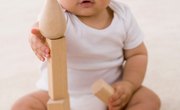Early childhood assessment tools are valuable in determining the developmental level that a child has attained. A narrative observation, also known as an anecdotal record, is a form of direct observation used by teachers and parents. The assessment method involves watching a child's activities and recording everything the educator observes. Writing down every detail in a factual manner is crucial and includes observation about the student's behavior, interactions with the environment and communication skills.
Label Your Narrative Observation Form
As you prepare for a student narrative observation, begin by simply writing "Narrative Observation Form" centered at the top of piece of paper. Next write "Child's name" and the name of the child you are observing, the date and time. Follow with "Child's age" and the child's exact age in years and months. Finally write "Observer's name" and your name with "Setting" and a brief description of the physical location where you are making the observations. If you plan on or are required to do repeated observations, creating an example of a narrative report in preschool on the computer can streamline the process with a printed option.
Narrative Observation and Interpretations
As you prepare for the narrative observation and making a diary records observation of that time, creating columns for notes is helpful. First, write "Narrative" on the left-hand side of the same page and then "Interpretations" on the right side of the page. Draw a line between the two words all the way to the bottom of the page for your future observations.
Setting the Parameters
Before bringing the preschool child into the process of a narrative observation, you need to determine the length of time needed and what processes you are observing. If the child is struggling with student to student interaction, setting the time parameters may be as simple as choosing recess time. If the student struggles with reading, the set time may be during silent reading for several days. While a narrative observation can take place in one setting, educators may also find it helpful to reassess over several days. In the preschool age range, shorter narrative observations may be necessary because the attention span of a preschooler is less than that of an older child.
Completing the Narrative Observation
Once you have the prepared paperwork and have set the time sample observation, move on to observing the selected preschooler. Write what you see and hear the child doing and saying on the left side of the page that has been designated for "narrative". Do not worry about writing interpretations until after the observation session ends. Record as many details as you can, no matter how insignificant they may seem at the time. For example; if the child laughs each time she plays with a toy, record every single laugh and toy interaction. At this point in the narrative observation process, you can compare your actions to being a video camera that is set to record without intervention. Even your smallest observations may be important.
Recording Interpreting Narrative Observations.
Finally, write your interpretations on the right side of the page that you designated as "interpretations". Ensure each interpretation corresponds to an observed behavior. For example; if you observed the preschooler pausing each time he put a puzzle piece in place, your written interpretation could be that he was using logic skills to figure out where the next piece fit. A background or knowledge of child development makes this the point that you can turn simple narrative observations into an interpretation of the child's actions. Transcribe your narrative observation into a computer without making any edits to what you wrote in either column. Your observations must be objective and based solely on what you saw. The subjective part of your observation occurs in your interpretation of the data and the child's actions. Keep your narrative recording to a single child to ensure you capture everything that the singular child does. Observing multiple children is difficult and does not provide an accurate picture of their individual activities. Printing out the completed narrative observations and interpretations of the preschooler can help create a long-term file.
Related Articles
References
Tips
- Your observations must be objective, based solely on what you saw. The subjective part of your observation occurs in your interpretation.
Warnings
- Keep your observation to a single child to ensure you capture everything that child does. Observing multiple children is difficult, and does not provide an accurate picture of their individual activities.
Writer Bio
Sampson Quain is a screenwriter and filmmaker who began writing in 1996. He has sold feature and television scripts to a variety of studios and networks including Columbia, HBO, NBC, Paramount and Lionsgate. He holds a Master of Fine Arts in screenwriting from the University of Southern California.











